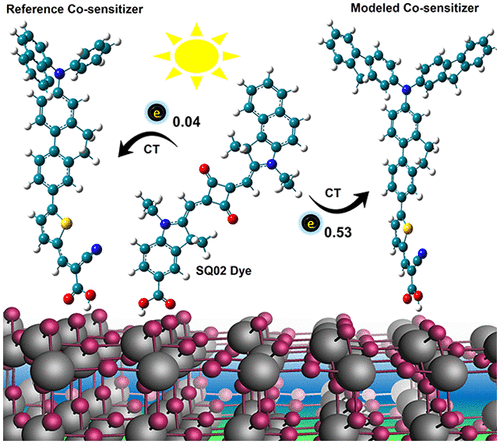当前位置:
X-MOL 学术
›
J. Chem. Inf. Model.
›
论文详情
Our official English website, www.x-mol.net, welcomes your
feedback! (Note: you will need to create a separate account there.)
Optimizing the Cosensitization Effect of SQ02 Dye on BP-2 Dye-Sensitized Solar Cells: A Computational Quantum Chemical Study
Journal of Chemical Information and Modeling ( IF 5.6 ) Pub Date : 2021-09-29 , DOI: 10.1021/acs.jcim.1c00739 Eman Nabil 1 , Ahmed A Hasanein 1 , Rua B Alnoman 2 , Mohamed Zakaria 1
Journal of Chemical Information and Modeling ( IF 5.6 ) Pub Date : 2021-09-29 , DOI: 10.1021/acs.jcim.1c00739 Eman Nabil 1 , Ahmed A Hasanein 1 , Rua B Alnoman 2 , Mohamed Zakaria 1
Affiliation

|
Cosensitization of the semiconducting electrode in dye-sensitized solar cells (DSCs), with two or more light-harvesting dyes, is a chemical fabrication method that aims to achieve a panchromatic absorption spectrum emulating that of the solar emission spectrum. In this paper, SQ02 and BP-2 cosensitizers have been investigated, as isolated monomers/dimer and adsorbed monomers/dimer on the TiO2 (101) anatase surface, by employing density functional theory (DFT) and time-dependent DFT calculations. Computed results showed that the dominant electron injection pathway is direct injection from each dye into the conduction band of TiO2. The almost complete spectral overlap between the simulated absorption spectrum of BP-2 and fluorescence emissions of SQ02 implies that excitation energy transfer occurs between cosensitizers via the trivial reabsorption mechanism. However, the results showed very limited unidirectional intermolecular charge transfer (CT) from SQ02 dye to BP-2 dye (0.04 |e–|). Therefore, this study also presents a stepwise molecular engineering of BP-2 dye, aiming at optimizing the cosensitization functionality. First, 14 redesigned dye candidates are reported to identify dyes with photophysical properties matching the requirements for efficient DSCs. Second, the four most promising dyes are shortlisted for testing as cosensitizers with the SQ02 dye. The molecular design factors of cosensitization that need validation are chemical compatibility, availability of CT between cosensitizers, and complementarity of the absorption spectra. This screening suggests the judicious choice of the modeled difluorenyl amine donor-based dye (BP-D4) as a very promising cosensitizer. In particular, the SQ02/BP-D4 dimer showed 10 times larger (0.53 |e–|) unidirectional CT than that of SQ02/BP-2 dimer, in addition to the maximum increased electron population of acceptor moieties upon photoexcitation.
中文翻译:

优化 SQ02 染料对 BP-2 染料敏化太阳能电池的共敏作用:计算量子化学研究
染料敏化太阳能电池 (DSC) 中的半导体电极与两种或多种光收集染料的共敏化是一种化学制造方法,旨在实现模拟太阳发射光谱的全色吸收光谱。在本文中,通过采用密度泛函理论 (DFT) 和时间相关的 DFT 计算,研究了 SQ02 和 BP-2 共敏剂,作为分离的单体/二聚体和吸附在 TiO 2 (101) 锐钛矿表面上的单体/二聚体。计算结果表明,主要的电子注入途径是从每种染料直接注入TiO 2的导带. BP-2 的模拟吸收光谱和 SQ02 的荧光发射之间几乎完全的光谱重叠意味着激发能量转移通过微不足道的重吸收机制在共敏剂之间发生。然而,结果显示从 SQ02 染料到 BP-2 染料的单向分子间电荷转移 (CT) 非常有限 (0.04 |e –|)。因此,本研究还提出了 BP-2 染料的逐步分子工程,旨在优化共敏功能。首先,报告了 14 种重新设计的候选染料,以识别具有符合高效 DSC 要求的光物理特性的染料。其次,四种最有前途的染料被列入候选名单,与 SQ02 染料一起作为共敏剂进行测试。需要验证的共敏化的分子设计因素是化学相容性、共敏剂之间 CT 的可用性以及吸收光谱的互补性。这种筛选表明,模型化的二芴胺供体染料 (BP-D4) 作为一种非常有前途的共敏剂是明智的选择。特别是,SQ02/BP-D4 二聚体显示出 10 倍大 (0.53 |e –|) 单向 CT 与 SQ02/BP-2 二聚体相比,除了光激发时受体部分的最大电子数量增加之外。
更新日期:2021-10-25
中文翻译:

优化 SQ02 染料对 BP-2 染料敏化太阳能电池的共敏作用:计算量子化学研究
染料敏化太阳能电池 (DSC) 中的半导体电极与两种或多种光收集染料的共敏化是一种化学制造方法,旨在实现模拟太阳发射光谱的全色吸收光谱。在本文中,通过采用密度泛函理论 (DFT) 和时间相关的 DFT 计算,研究了 SQ02 和 BP-2 共敏剂,作为分离的单体/二聚体和吸附在 TiO 2 (101) 锐钛矿表面上的单体/二聚体。计算结果表明,主要的电子注入途径是从每种染料直接注入TiO 2的导带. BP-2 的模拟吸收光谱和 SQ02 的荧光发射之间几乎完全的光谱重叠意味着激发能量转移通过微不足道的重吸收机制在共敏剂之间发生。然而,结果显示从 SQ02 染料到 BP-2 染料的单向分子间电荷转移 (CT) 非常有限 (0.04 |e –|)。因此,本研究还提出了 BP-2 染料的逐步分子工程,旨在优化共敏功能。首先,报告了 14 种重新设计的候选染料,以识别具有符合高效 DSC 要求的光物理特性的染料。其次,四种最有前途的染料被列入候选名单,与 SQ02 染料一起作为共敏剂进行测试。需要验证的共敏化的分子设计因素是化学相容性、共敏剂之间 CT 的可用性以及吸收光谱的互补性。这种筛选表明,模型化的二芴胺供体染料 (BP-D4) 作为一种非常有前途的共敏剂是明智的选择。特别是,SQ02/BP-D4 二聚体显示出 10 倍大 (0.53 |e –|) 单向 CT 与 SQ02/BP-2 二聚体相比,除了光激发时受体部分的最大电子数量增加之外。











































 京公网安备 11010802027423号
京公网安备 11010802027423号